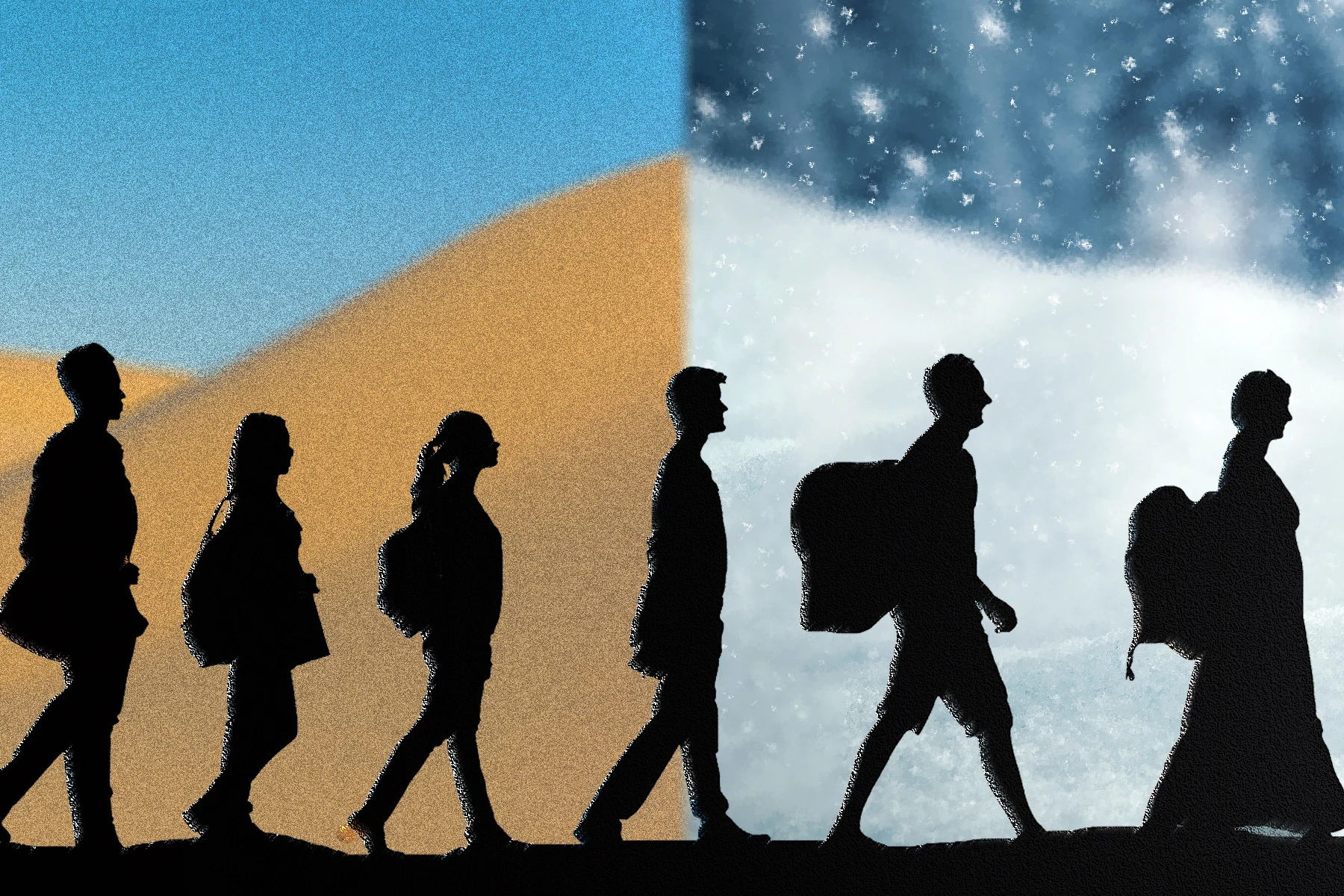Climate change could speed the next wave of mass migration as people cope with a warming world, with significant risks and consequences. But where will people go?
For many, the answers won’t be simple or pleasant. Migration entails large personal costs, which often cannot be paid upfront by those forced to move. The burst of widespread anti-immigrant sentiments also suggests that, even when people can afford to move, political barriers may limit where individuals would like to relocate.
People from tropical climates will likely face the most painful choices. Even if they move long before weather shocks set in, it might be in their best interest to choose a climate that differs from the one to which they’re accustomed.
Consider, for example, that equatorial latitudes are much hotter than northern ones, and colder areas are becoming warmer at a faster rate. This implies that places near the equator will suffer more than places closer to the poles, like Northern Europe, Russia, and Canada, which may even gain from global warming.
Are people from hotter climates, such as Somalia, willing to move to much colder ones, such as Minnesota? If so, how would they fare? Answering these questions is crucial to fully assessing the costs and benefits of migration as a coping mechanism to climate change.
Why people move from one cold climate to another
I recently analyzed the consequences of climate mismatch in research conducted with Marguerite Obolensky, a doctoral candidate at Columbia University, and Harvard Kennedy School professor Charles A. Taylor. We studied whether migrants seek familiar climates when choosing destinations, and evaluated the consequences of a mismatch. For centuries, migrants have been worrying about the weather of their new home locales:
As early as the 1600s, English migrants to North America and the West Indies expressed “profound anxiety” about the health and productivity impacts of climates that diverged from England's temperate climate. Englishman Sir Ferdinando Gorges noted that New England was “more suitable to the nature of our people, who neither find content in the colder climates, nor health in the hotter.”
In the 1920s, US President Calvin Coolidge observed that “newcomers from Europe commonly sought climatic conditions here like those in which they had been raised. So the Scandinavians are found chiefly in the northern parts of this country.”
That’s because—according to our analysis of census and mortality records—it’s human nature to seek a climate that’s similar to the one you’re leaving. Our study considers international and internal migration in the United States in 1880 and between 1988-2005, enabling us to compare the historical and modern periods.
We found that immigrants coming from warmer countries settled in warmer parts of the US, and vice versa for colder places. These results hold across time periods, including today, and go beyond factors such as geographic convenience, climate distance, economic conditions, or past migration patterns.
Does the relationship between climate distance and migration hold when immigrants continue to move within their new home country? Historical records offer some answers:
When we analyzed the spatial distribution of German surnames—a novel approach—in the US at the turn of the 20th century, we found that these immigrants gravitated toward regions whose climates felt similar to Germany’s. At the time, German immigrants accounted for 30 percent of the foreign-born population.
Using the 1865 Norwegian census and the 1880 US census, we found that the more than 250,000 Norwegians who immigrated to America between those years settled in cold locales. In 1865, Norway lost 15 percent of its population to emigration to the US.
Even people who were already settled in the US but opted to move further west between 1850 and 1940 stuck to familiar climates, according to census data.
Why do people long for the environmental conditions they know? One clear explanation is that they have the skills and experience to survive and prosper in a particular region. Farmers, for example, know which foods to plant and understand the conditions.
However, we no longer live in an agrarian society—less than 3 percent of the US labor force still works the land for income. Perhaps another reason behind people’s tendency to stick to the climates they know involve deeply engrained preferences and culture.
The grave consequences of climate mismatch
You might think that moving from, say, Maine to Florida isn’t a big deal, but it can be. In fact, our research suggests that a climate mismatch can shorten one’s life.
Using US mortality records from 1988 to 2005, we found that when a migrant’s climate was 6.5 degrees Celsius hotter than the conditions they were used to in their country of origin, it reduced their life expectancy by about 50 days. This number is similar to estimates for the effects of consuming one alcoholic drink per day. This was the case even with a sample in which the average age at death was 80.
When people don’t choose a familiar climate, they might lack the survival skills that can only be gained from living in such conditions. They must adapt, which can be costly and take time.
This could mean learning to drive on icy roads or cope with longer periods of darkness in a northern climate. People moving from a cold to a tropical climate may not realize the dangers of spending time outside in the hottest hours. Moreover, since social norms and socialization are tied to climate, migrants who end up living in an environment they’re unaccustomed to may become isolated and depressed.
The costs of climate mismatch continue to be borne by the next generation. US data from between 2005 and 2021 shows that infant mortality is higher for the children of immigrants who were born in parts of the US that are climatically more distant from their parents’ country of origin. Our estimates imply that for every additional Celsius degree of mismatch between the child’s birth county and the parent’s country of origin, the infant mortality rate increases by approximately 6 percent. This is comparable to the impact of pesticides use on infant deaths in the US over the past 20 years. We detect similar, negative effects of climate mismatch also on other proxies of infant health, such as the probability of low-birth weight and premature birth.
There’s a cost to a climate mismatch for migrants. Using the Environmental Protection Agency’s value of statistical life, a figure associated with avoiding fatality, and our data, we find that each degree of temperature difference between a migrant’s origin and destination costs them around $1,990. This is a sizable number. Consider, for instance, that getting from Central American countries to Texas, and evade Customs and Border Patrol, costs between $9,000 to $12,000, by some estimates.
Where do we go from here?
When people move from hot to cold countries, in particular, they need time to adapt to the new climate. This can be important for the design of refugee resettlement policies. For example, consider that Minneapolis, the coldest large city in the US, has welcomed the largest number of people moving from Somalia, which is one of the hottest countries in the world, to the US.
Armed with this data, policymakers who understand the high stakes of matching could design more effective programs to support the people and communities most vulnerable to climate change, especially refugees. In particular, we hope that policymakers will ask themselves how they can:
Help migrants resettle in climates comparable to the regions they left.
Identify mismatched migrants who are struggling and might thrive in a more familiar climate.
Design programs that help people adapt to a new climate if there are no other options.
Better climate matching has the potential to improve refugees’ outcomes and promote the assimilation of immigrants—issues that are relevant not only to their communities, but society at large.
Image by HBSWK with assets from AdobeStock.


